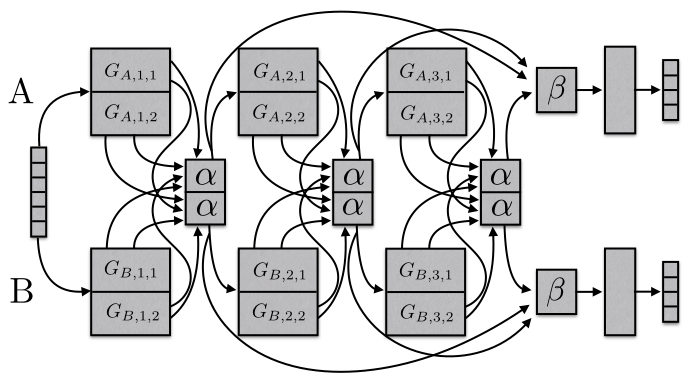sebastianruder / Sluice Networks
Programming Languages
Projects that are alternatives of or similar to Sluice Networks
Sluice networks: Learning what to share between loosely related tasks
Sebastian Ruder, Joachim Bingel, Isabelle Augenstein, Anders Søgaard (2017). Sluice networks: Learning what to share between loosely related tasks. arXiv preprint arXiv:1705.08142.
Installation instructions
The code works with Python 3.5. The main requirement is DyNet (and its dependencies).
DyNet can be installed using the instructions here (the detailed instructions, not TL;DR).
Besides that, we use progress to track the training progress, which can be
installed via pip install progress.
Repository structure
-
constants.py: Contains constants used across all files. -
predictors.py: Contains classes for sequence predictors and layers. -
PTB2chunks.py: A script to extract chunks from the PTB format. -
run_sluice_net.py: Script to train, load, and evaluate SluiceNetwork. -
sluice_net.py: The main logic for the SluiceNetwork. -
utils.py: Utility methods for data processing.
Model
The code for the Bi-LSTM we use as basis for SluiceNetwork is based on the state-of-the-art hierarchical Bi-LSTM tagger by Plank et al. (2016). You can find their repo here. For most of the Bi-LSTM hyperparameters, we adopt their choices.
Example usage
python run_sluice_net.py --dynet-autobatch 1 --dynet-seed 123 \
--task-names chunk pos --h-layers 3 --pred-layer 3 3 \
--cross-stitch --layer-connect stitch \
--num-subspaces 2 --constraint-weight 0.1 \
--constrain-matrices 1 2 --patience 3 \
--train-dir ontonotes-5.0/train \
--dev-dir ontonotes-5.0/development \
--test-dir ontonotes-5.0/test \
--train bc --test bn mz nw wb \
--model-dir model/chunk_3_pos_3_bc_mz --log-dir logs
-
--dynet-autobatch 1: use DyNet auto-batching -
--dynet-seed 123: provide a seed to DyNet -
--task-names chunk pos: run the model with chunking as main task and POS tagging as auxiliary task -
--h-layers 3: use 3 layers in the model -
--cross-stitch: use cross-stitch (alpha) units -
--layer-connect stitch: use layer-stitch (beta) units before the FC layer -
--num-subspaces 2: use two subspaces -
--constraint-weight 0.1: use subspace orthogonality constraint with a weight of 0.1 -
--constrain-matrices 1 2: place the constraint on the LSTM matrices with indices 1 and 2 -
--patience 3: use patience 3 for training -
--train-dir,--dev-dir,--test-dir: use the specified directories for training, development, and testing (thetrain,development, andtestdirectories of the CoNLL formatted OntoNotes 5.0 data) -
--train bc: train the model on thebcdomain -
--test bn mz nw wb: test the model on thebn,mz,nw, andwbdomains -
--model-dir: the directory of the model -
--log-dir: the directory for logging
Data
We use the English OntoNotes v5.0 data in the format used by the CoNLL 2011/2012 shared task.
In order to obtain the data, you need to follow these steps:
- Obtain the OntoNotes v5.0 data from the LDC. Most universities have a copy of it.
- Convert the data to the CoNLL 2011/2012 format using the scripts here.
Following this, you will have a file tree that looks like the following:
conll-formatted-ontonotes-5.0/
└── data
├── development
| └── data
| └── english
| └── annotations
| ├── bc
| ├── bn
| ├── mz
| ├── nw
| ├── pt
| ├── tc
| └── wb
├── test
│ └── data
│ └── english
│ └── annotations
│ ├── bc
│ ├── bn
│ ├── mz
│ ├── nw
│ ├── pt
│ ├── tc
│ └── wb
└── train
└── data
└── english
└── annotations
├── bc
├── bn
├── mz
├── nw
├── pt
├── tc
└── wb
A leaf folder such as bc has the following structure:
bc
├── cctv
| └── 00
├── cnn
| └── 00
├── msnbc
| └── 00
├── p2.5_a2e
| └── 00
├── p2.5_c23
| └── 00
└── phoenix
└── 00
Each 00 folder should then contain *.gold_skel files containing the CoNLL
skeleton annotations and *.gold_conll files containing the word forms and
annotations in CoNLL format.
The *.gold_conll files contain annotations for POS tagging, parsing,
word sense disambiguation, named entity recognition (NER), semantic role
labeling (SRL), and coreference resolution (see
here).
We only use POS tags, NER labels and predicate labels of SRL in our
experiments.
In order to obtain annotations for chunking, run the provided PTB2chunks.py
script with the following command:
python PTB2chunks.py --original-folder ORIG_FOLDER --conll-folder CONLL_FOLDER
where ORIG_FOLDER is the root of the original OntoNotes 5.0 data directory
(where annotations is the first subdirectory) and --conll-folder is the
conll-formatted-ontonotes-5.0/ directory above.
The script will then extract the chunk annotations and create *.chunks files
that are saved next to *.gold_skel and *.gold_conll.
Reference
If you make use of the contents of this repository, we appreciate citing the following paper:
@article{ruder2017sluice,
title={Sluice networks: Learning what to share between loosely related tasks},
author={Ruder, Sebastian and Bingel, Joachim and Augenstein, Isabelle and S{\o}gaard, Anders},
journal={arXiv preprint arXiv:1705.08142},
year={2017}
}

